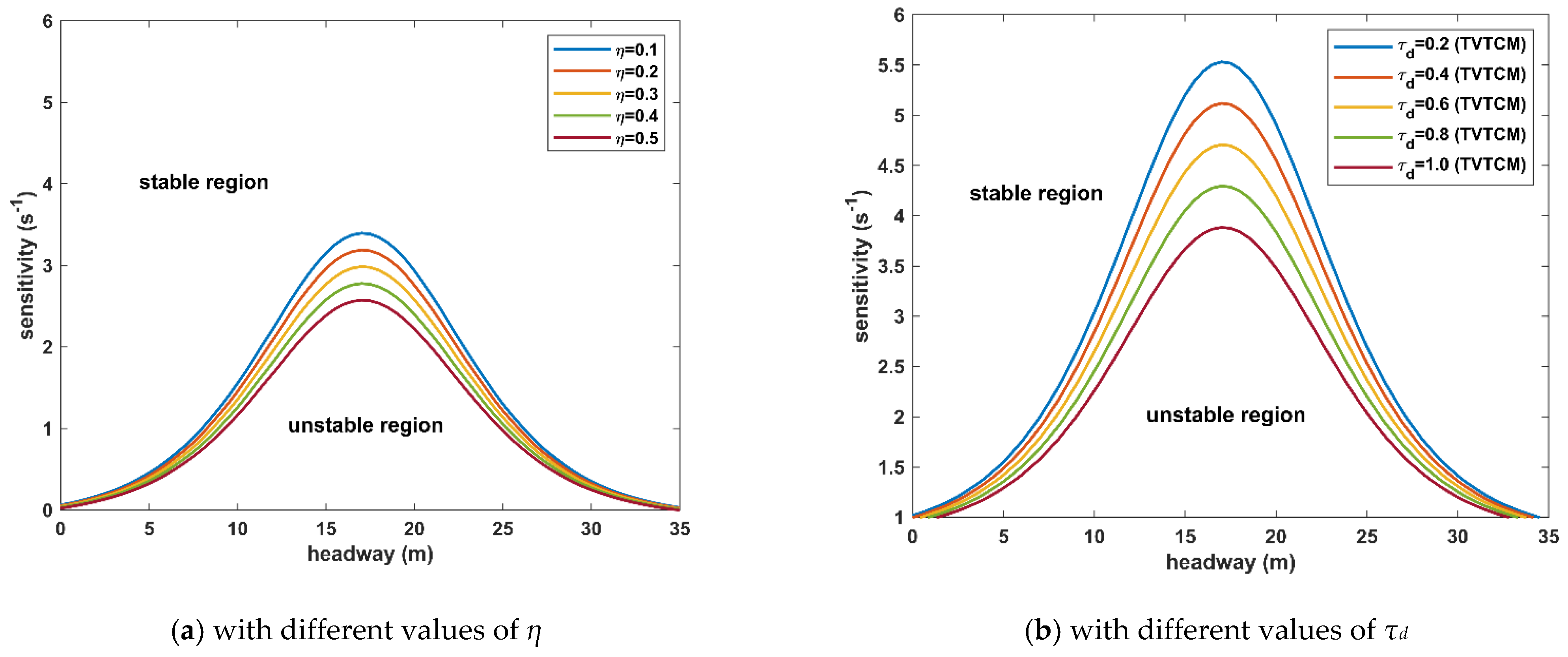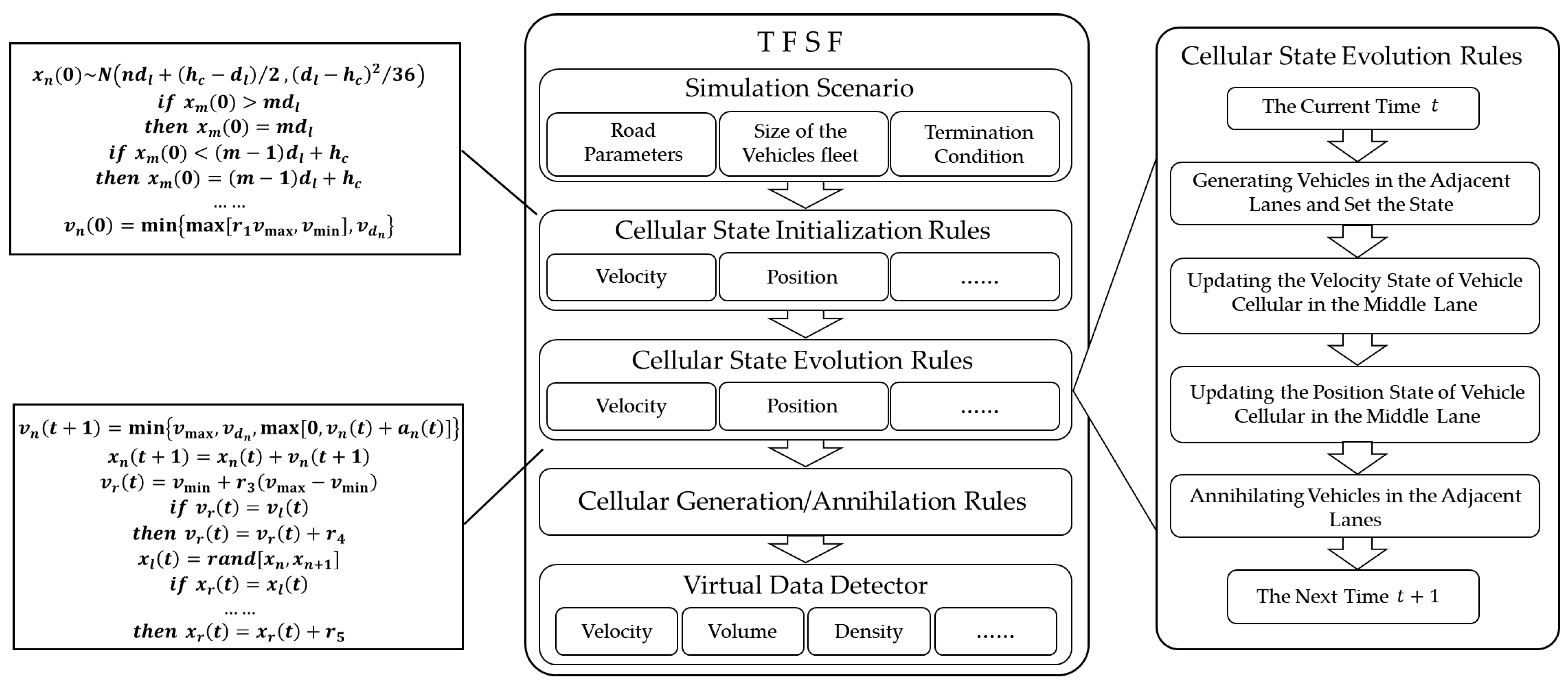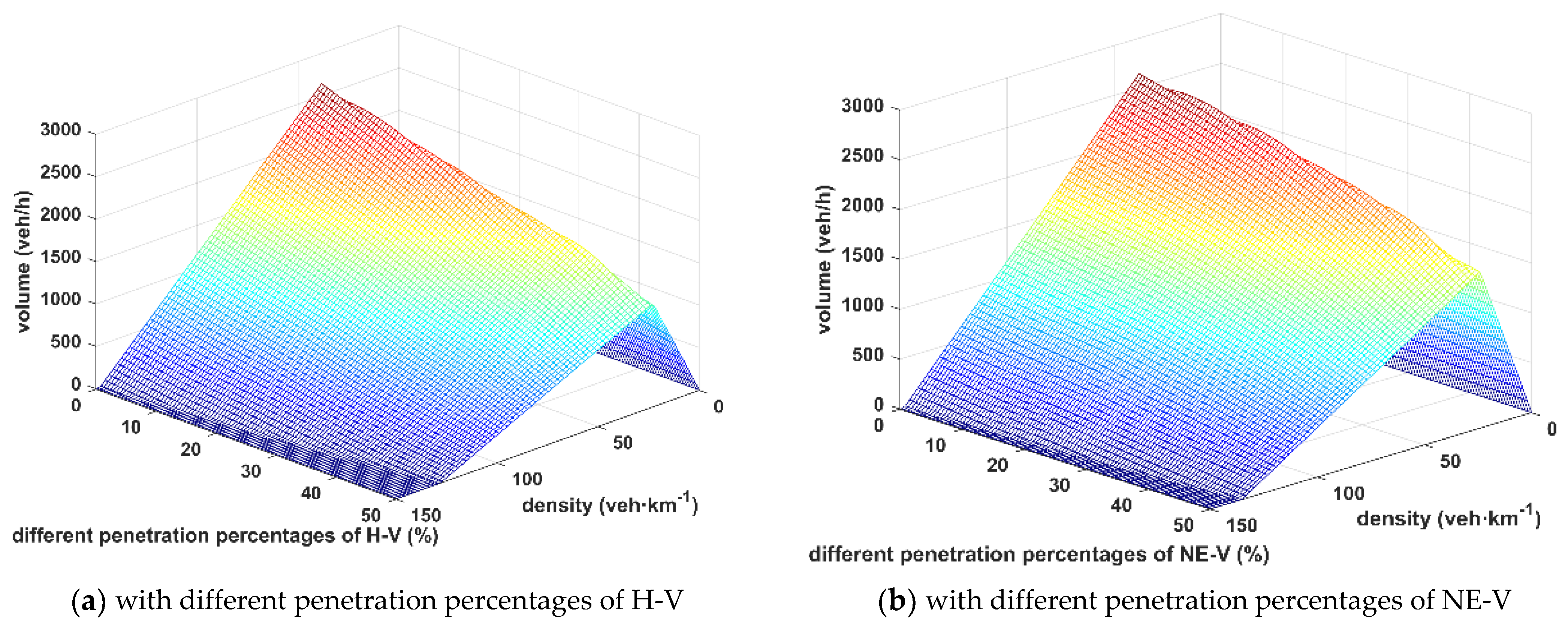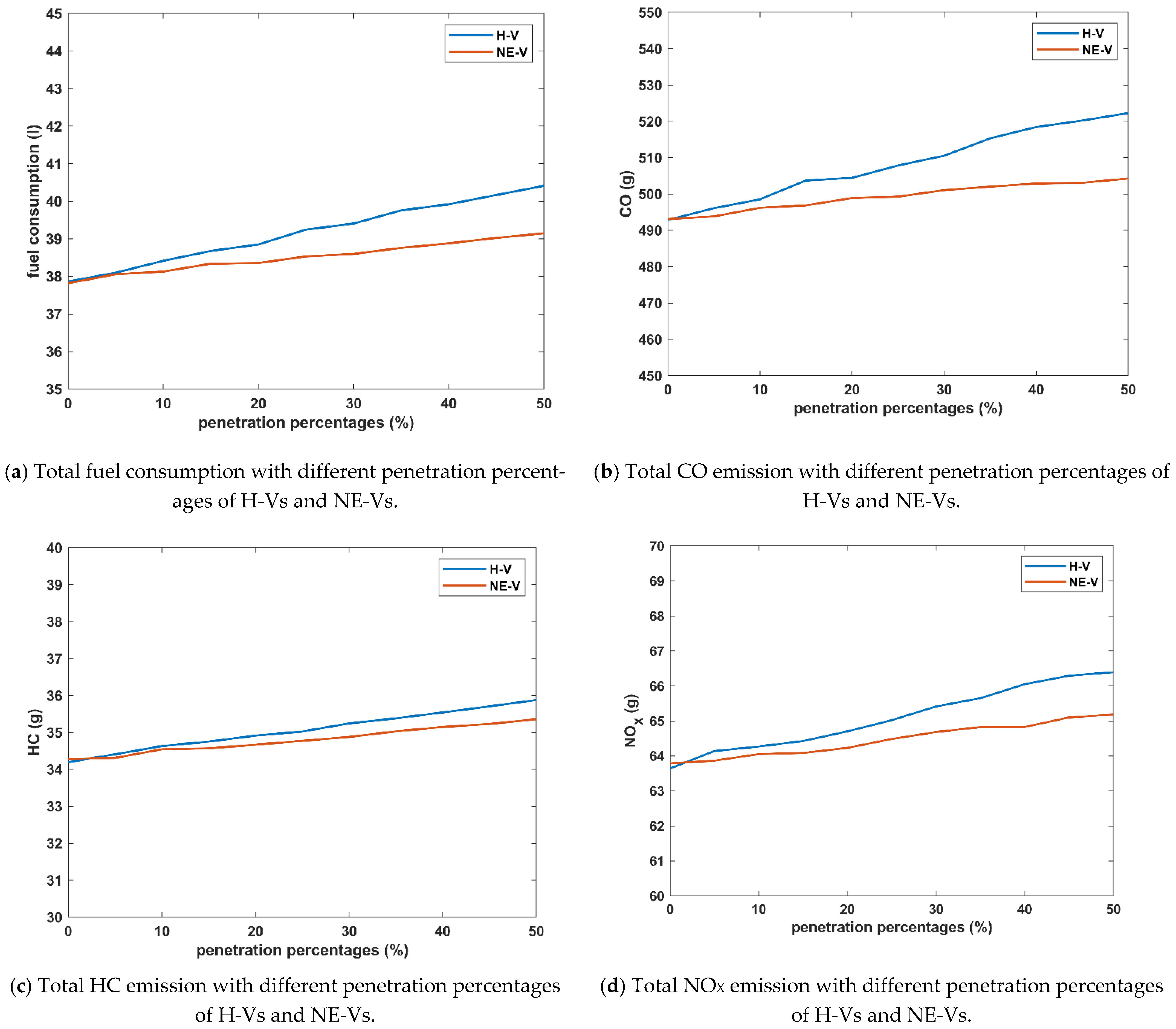Research on the Impacts of Vehicle Type on Car-Following Behavior, Fuel Consumption and Exhaust Emission in the V2X Environment
Abstract
1. Introduction
- The impacts of new energy and other types of preceding vehicles on car-following behavior;
- The impacts of new energy and other types of preceding vehicles on traffic flow;
- The impacts of new energy and other types of preceding vehicles on fuel consumption and exhaust emission.
2. Car-Following Model
2.1. Car-Following Behavior Characteristics Analysis
- The preceding vehicle is an H-V.
- The preceding vehicle is NE-V.
2.2. Modeling Car-Following Behavior
- (1)
- There is an inflection point at .
- (2)
- , when .
- (3)
- , when .
- (1)
- Drivers avoid the collision, and the following velocity depends on the headway.
- (2)
- Drivers will pursue higher velocity when conditions permit, but there is an upper limit of velocity due to restrictions of road or vehicle physical characteristics.
3. Platoon Stability Analysis
4. Numerical Simulation
4.1. Car-Following Behavior Characteristics
Virtual Scenario
4.2. Traffic Flow Characteristics
Virtual Scenario
4.3. Fuel Consumption and Exhaust Emission
Virtual Scenario
5. Discussion
- The influence of model parameters’ value has been discussed in theoretical analysis and numerical simulation. However, calibration using field data is not carried out. Considering the absence of suitable field data and the difficulty in building such a data set, this limitation will be dealt with in one of our planned works.
- There are parameters to represent different drivers’ sensitivity to the impact of H-Vs and NE-Vs in the extended car-following model proposed in this paper. Humans are typically a complex, heterogeneous groups, and various drivers’ reaction to the penetration of H-Vs and NE-Vs needs to be further explored.
- The VT-Micro model proposed by Ahn was employed to calculate the vehicles’ fuel consumption and exhaust emissions. Although this model has been widely used, and the performance has been acknowledged, there will be a deviation between the calculated results and the real value due to the diverse vehicles that are put on the market. Despite that the VT-Micro model can be used to explore the difference and changes in fuel consumption and exhaust emission, further calibration works should be carried out.
6. Conclusions
Author Contributions
Funding
Institutional Review Board Statement
Informed Consent Statement
Data Availability Statement
Conflicts of Interest
References
- Babojelic, K.; Novacko, L. Modelling of driver and pedestrian behaviour—A historical review. Promet Traffic Transp. 2020, 32, 727–745. [Google Scholar] [CrossRef]
- Longhai, Y.; Chun, Z.; Xiaoyun, Q.; Shuai, L.; Hui, W. Research Progress on Car-Following Models. J. Traffic Transp. Eng. 2019, 19, 125–138. [Google Scholar]
- Zhengbing, H.; Ruikang, X.; Dongfan, X.; Fang, Z.; Renxin, Z. A Review of Data-Driven Car-Following Models. J. Transp. Syst. Eng. Inf. Technol. 2021, 21, 102–113. [Google Scholar]
- Han, J.; Wang, X.; Wang, G. Modeling the Car-Following Behavior with Consideration of Driver, Vehicle, and Environment Factors: A Historical Review. Sustainability 2022, 14, 8179. [Google Scholar] [CrossRef]
- Li, Y.; Sun, D.; Liu, W.; Zhang, M.; Zhao, M.; Liao, X.; Tang, L. Modeling and Simulation for Microscopic Traffic Flow Based on Multiple Headway, Velocity and Acceleration Difference. Nonlinear Dyn. 2011, 66, 15–28. [Google Scholar] [CrossRef]
- Sun, D.; Kang, Y.; Yang, S. A Novel Car Following Model Considering Average Speed of Preceding Vehicles Group. Phys. A Stat. Mech. Appl. 2015, 436, 103–109. [Google Scholar] [CrossRef]
- Kuang, H.; Xu, Z.; Li, X.; Lo, S. An Extended Car-Following Model Accounting for the Average Headway Effect in Intelligent Transportation System. Phys. A Stat. Mech. Appl. 2017, 471, 778–787. [Google Scholar] [CrossRef]
- Zhu, W.; Zhang, L. A New Car-Following Model for Autonomous Vehicles Flow with Mean Expected Velocity Field. Phys. A Stat. Mech. Appl. 2018, 492, 2154–2165. [Google Scholar] [CrossRef]
- Yu, G.; Wang, P.; Wu, X.; Wang, Y. Linear and Nonlinear Stability Analysis of a Car-Following Model Considering Velocity Difference of Two Adjacent Lanes. Nonlinear Dyn. 2016, 84, 387–397. [Google Scholar] [CrossRef]
- Gao, Z.; Zhang, N.; Mannini, L.; Cipriani, E. The Car Following Model with Relative Speed in Front on the Three-Lane Road. Discret. Dyn. Nat. Soc. 2018, 2018, 7560493. [Google Scholar] [CrossRef]
- Han, J.; Zhang, J.; Wang, X.; Liu, Y.; Wang, Q.; Zhong, F. An Extended Car-Following Model Considering Generalized Preceding Vehicles in V2X Environment. Future Internet 2020, 12, 216. [Google Scholar] [CrossRef]
- Tang, T.; Shi, W.; Shang, H.; Wang, Y. A New Car-Following Model with Consideration of Inter-Vehicle Communication. Nonlinear Dyn. 2014, 76, 2017–2023. [Google Scholar] [CrossRef]
- Ou, H.; Tang, T.-Q. An Extended Two-Lane Car-Following Model Accounting for Inter-Vehicle Communication. Phys. A 2018, 495, 260–268. [Google Scholar] [CrossRef]
- Tang, T.-Q.; Yi, Z.-Y.; Zhang, J.; Zheng, N. Modelling the Driving Behaviour at a Signalised Intersection with the Information of Remaining Green Time. IET Intell. Transp. Syst. 2017, 11, 596–603. [Google Scholar] [CrossRef]
- Zhao, J.; Li, P. An Extended Car-Following Model with Consideration of Speed Guidance at Intersections. Phys. A 2016, 461, 1–8. [Google Scholar] [CrossRef]
- Zhao, J.; Li, P. An Extended Car-Following Model with Consideration of Vehicle to Vehicle Communication of Two Conflicting Streams. Phys. A 2017, 473, 178–187. [Google Scholar] [CrossRef]
- Ci, Y.; Wu, L.; Zhao, J.; Sun, Y.; Zhang, G. V2I-Based Car-Following Modeling and Simulation of Signalized Intersection. Phys. A 2019, 525, 672–679. [Google Scholar] [CrossRef]
- Peeta, S.; Zhang, P.C.; Zhou, W.M. Behavior-Based Analysis of Freeway Car-Truck Interactions and Related Mitigation Strategies. Transp. Res. Part B Methodol. 2005, 39, 417–451. [Google Scholar] [CrossRef]
- Aghabayk, K.; Sarvi, M.; Young, W. Understanding the Dynamics of Heavy Vehicle Interactions in Car-Following. J. Transp. Eng. 2012, 138, 1468–1475. [Google Scholar] [CrossRef]
- Aghabayk, K.; Sarvi, M.; Young, W. Attribute Selection for Modelling Driver’s Car-Following Behaviour in Heterogeneous Congested Traffic Conditions. Transp. A 2014, 10, 457–468. [Google Scholar] [CrossRef]
- Rakha, H.; Wang, W. Procedure for Calibrating Gipps Car-Following Model. Transp. Res. Rec. 2009, 2124, 113–124. [Google Scholar] [CrossRef]
- Ossen, S.; Hoogendoorn, S.P. Heterogeneity in Car-Following Behavior: Theory and Empirics. Transp. Res. Part C Emerg. Technol. 2011, 19, 182–195. [Google Scholar] [CrossRef]
- Mathew, T.V.; Ravishankar, K.V.R. Car-Following Behavior in Traffic Having Mixed Vehicle-Types. Transp. Lett. 2011, 3, 109–122. [Google Scholar] [CrossRef]
- Asaithambi, G.; Kanagaraj, V.; Srinivasan, K.K.; Sivanandan, R. Study of Traffic Flow Characteristics Using Different Vehicle-Following Models under Mixed Traffic Conditions. Transp. Lett. 2018, 10, 92–103. [Google Scholar] [CrossRef]
- Raju, N.; Arkatkar, S.; Joshi, G. Modeling Following Behavior of Vehicles Using Trajectory Data under Mixed Traffic Conditions: An Indian Viewpoint. Transp. Lett. 2021, 13, 649–663. [Google Scholar] [CrossRef]
- Nagahama, A.; Yanagisawa, D.; Nishinari, K. Car-Following Characteristics of Various Vehicle Types in Respective Driving Phases. Transp. B Transp. Dyn. 2020, 8, 22–48. [Google Scholar] [CrossRef]
- Sarvi, M. Heavy Commercial Vehicles-Following Behavior and Interactions with Different Vehicle Classes. J. Adv. Transp. 2013, 47, 572–580. [Google Scholar] [CrossRef]
- Kong, D.; Guo, X.; Yang, B.; Wu, D. Analyzing the Impact of Trucks on Traffic Flow Based on an Improved Cellular Automaton Model. Discret. Dyn. Nat. Soc. 2016, 2016, 1236846. [Google Scholar] [CrossRef]
- Aghabayk, K.; Sarvi, M.; Young, W. Including Heavy Vehicles in a Car-Following Model: Modelling, Calibrating and Validating. J. Adv. Transp. 2016, 50, 1432–1446. [Google Scholar] [CrossRef]
- Zheng, L.; Jin, P.J.; Huang, H.; Gao, M.; Ran, B. A Vehicle Type-Dependent Visual Imaging Model for Analysing the Heterogeneous Car-Following Dynamics. Transp. B Transp. Dyn. 2016, 4, 68–85. [Google Scholar] [CrossRef]
- Wu, P.; Gao, F.; Li, K. A Vehicle Type Dependent Car-Following Model Based on Naturalistic Driving Study. Electronics 2019, 8, 453. [Google Scholar] [CrossRef]
- Ahangar, M.N.; Ahmed, Q.Z.; Khan, F.A.; Hafeez, M. A Survey of Autonomous Vehicles: Enabling Communication Technologies and Challenges. Sensors 2021, 21, 706. [Google Scholar] [CrossRef] [PubMed]
- Abdelkader, G.; Elgazzar, K.; Khamis, A. Connected Vehicles: Technology Review, State of the Art, Challenges and Opportunities. Sensors 2021, 21, 7712. [Google Scholar] [CrossRef] [PubMed]
- Han, J.; Shi, H.; Chen, L.; Li, H.; Wang, X. The Car-Following Model and Its Applications in the V2X Environment: A Historical Review. Future Internet 2022, 14, 14. [Google Scholar] [CrossRef]
- Li, Y.; Zhang, L.; Zheng, H.; He, X.; Peeta, S.; Zheng, T.; Li, Y. Nonlane-Discipline-Based Car-Following Model for Electric Vehicles in Transportation-Cyber-Physical Systems. IEEE Trans. Intell. Transp. Syst. 2018, 19, 38–47. [Google Scholar] [CrossRef]
- Qu, X.; Yu, Y.; Zhou, M.; Lin, C.-T.; Wang, X. Jointly Dampening Traffic Oscillations and Improving Energy Consumption with Electric, Connected and Automated Vehicles: A Reinforcement Learning Based Approach. Appl. Energy 2020, 257, 114030. [Google Scholar] [CrossRef]
- Xu, Y.; Zheng, Y.; Yang, Y. On the Movement Simulations of Electric Vehicles: A Behavioral Model-Based Approach. Appl. Energy 2021, 283, 116356. [Google Scholar] [CrossRef]
- Yoong, M.K.; Gan, Y.H.; Gan, G.D.; Leong, C.K.; Phuan, Z.Y.; Cheah, B.K.; Chew, K.W. Studies of Regenerative Braking in Electric Vehicle. In Proceedings of the 2010 IEEE Conference on Sustainable Utilization and Development in Engineering and Technology, Kuala Lumpur, Malaysia, 20–21 November 2010; pp. 40–45. [Google Scholar]
- Mahmoudi, C.; Flah, A.; Sbita, L. An Overview of Electric Vehicle Concept and Power Management Strategies. In Proceedings of the 2014 International Conference on Electrical Sciences and Technologies in Maghreb (CISTEM), Tunis, Tunisia, 3–6 November 2014; pp. 1–8. [Google Scholar]
- Tian, C.; Sun, D.; Zhang, M. Nonlinear Analysis of Lattice Model with Consideration of Optimal Current Difference. Commun. Nonlinear Sci. Numer. Simul. 2011, 16, 4524–4529. [Google Scholar] [CrossRef]
- Zhou, T.; Sun, D.; Kang, Y.; Li, H.; Tian, C. A New Car-Following Model with Consideration of the Prevision Driving Behavior. Commun. Nonlinear Sci. Numer. Simul. 2014, 19, 3820–3826. [Google Scholar] [CrossRef]
- Yu, S.; Shi, Z. An Improved Car-Following Model Considering Relative Velocity Fluctuation. Commun. Nonlinear Sci. Numer. Simul. 2016, 36, 319–326. [Google Scholar] [CrossRef]
- Yu, S.; Zhao, X.; Xu, Z.; Zhang, L. The Effects of Velocity Difference Changes with Memory on the Dynamics Characteristics and Fuel Economy of Traffic Flow. Phys. A Stat. Mech. Appl. 2016, 461, 613–628. [Google Scholar] [CrossRef]
- Ma, C.; Hao, W.; Wang, A.; Zhao, H. Developing a Coordinated Signal Control System for Urban Ring Road Under the Vehicle-Infrastructure Connected Environment. IEEE Access 2018, 6, 52471–52478. [Google Scholar] [CrossRef]
- Ma, C.; Hao, W.; Xiang, W.; Yan, W. The Impact of Aggressive Driving Behavior on Driver-Injury Severity at Highway-Rail Grade Crossings Accidents. J. Adv. Transp. 2018, 2018, 9841498. [Google Scholar] [CrossRef]
- Ma, C.; Wang, C.; Xu, X. A Multi-Objective Robust Optimization Model for Customized Bus Routes. IEEE Trans. Intell. Transp. Syst. 2021, 22, 2359–2370. [Google Scholar] [CrossRef]
- Ma, C.; Zhao, Y.; Dai, G.; Xu, X.; Wong, S.-C. A Novel STFSA-CNN-GRU Hybrid Model for Short-Term Traffic Speed Prediction. IEEE Trans. Intell. Transp. Syst. 2022, 1–10. [Google Scholar] [CrossRef]
- Dayi, Q.; Zixu, Z.; Yanfeng, J.; Tao, W. Interaction Potential-Based Complex Characteristics and Models for Car-Following. Complex Syst. Complex. Sci. 2022, 19, 87–95. [Google Scholar]
- Yanfeng, J.; Dayi, Q.; Zixu, Z.; Tao, W.; Hui, S. Car-Following Decision-Making and Model for Connected and Autonomous Vehicles Based on Safety Potential Field. J. Transp. Syst. Eng. Inf. Technol. 2022, 22, 85–97. [Google Scholar]
- Chowdhury, D.; Santen, L.; Schadschneider, A. Statistical Physics of Vehicular Traffic and Some Related Systems. Phys. Rep. 2000, 329, 199–329. [Google Scholar] [CrossRef]
- Helbing, D.; Tilch, B. Generalized Force Model of Traffic Dynamics. Phys. Rev. E 1998, 58, 133–138. [Google Scholar] [CrossRef]
- Bando, M.; Hasebe, K.; Nakayama, A.; Shibata, A.; Sugiyama, Y. Dynamical model of traffic congestion and numerical-simulation. Phys. Rev. E 1995, 51, 1035–1042. [Google Scholar] [CrossRef]
- Jiang, R.; Wu, Q.S.; Zhu, Z.J. Full Velocity Difference Model for a Car-Following Theory. Phys. Rev. E 2001, 64, 017101. [Google Scholar] [CrossRef] [PubMed]
- Nagatani, T.; Nakanishi, K.; Emmerich, H. Phase Transition in a Difference Equation Model of Traffic Flow. J. Phys. A Math. Gen. 1998, 31, 5431–5438. [Google Scholar] [CrossRef]
- Wang, X.; Han, J.; Bai, C.; Shi, H.; Zhang, J.; Wang, G. Research on the Impacts of Generalized Preceding Vehicle Information on Traffic Flow in V2X Environment. Future Internet 2021, 13, 88. [Google Scholar] [CrossRef]
- Ahn, K.; Rakha, H.; Trani, A.; Aerde, M.V. Estimating Vehicle Fuel Consumption and Emissions Based on Instantaneous Speed and Acceleration Levels. J. Transp. Eng. 2002, 128, 182–190. [Google Scholar] [CrossRef]
- Yu, S.; Tang, J.; Xin, Q. Relative Velocity Difference Model for the Car-Following Theory. Nonlinear Dyn. 2018, 91, 1415–1428. [Google Scholar] [CrossRef]
- Jiao, S.; Zhang, S.; Zhou, B.; Zhang, Z.; Xue, L. An Extended Car-Following Model Considering the Drivers’ Characteristics under a V2V Communication Environment. Sustainability 2020, 12, 1552. [Google Scholar] [CrossRef]






| Fuel | CO | HC | NOX | |
|---|---|---|---|---|
| −0.679439 | 0.887447 | −0.728042 | −1.067682 | |
| 0.135273 | 0.148841 | 0.012211 | 0.254363 | |
| 0.015946 | 0.030550 | 0.023371 | 0.008866 | |
| −0.001189 | −0.001348 | −0.000093243 | −0.000951 | |
| 0.029665 | 0.070994 | 0.024950 | 0.046423 | |
| −0.000276 | −0.000786 | −0.000205 | −0.000173 | |
| 0.000001487 | 0.000004616 | 0.000001949 | 0.000000569 | |
| 0.004808 | 0.003870 | 0.010145 | 0.015482 | |
| −0.000020535 | 0.000093228 | −0.000103 | −0.000131 | |
| 5.5409285 × 10−8 | −0.000000706 | 0.000000618 | 0.000000328 | |
| 0.000083329 | −0.000926 | −0.000549 | 0.002876 | |
| 0.000000937 | 0.000049181 | 0.000037592 | −0.00005866 | |
| −2.479644 × 10−8 | −0.000000314 | −0.000000213 | 0.00000024 | |
| −0.000061321 | 0.000046144 | −0.000113 | −0.000321 | |
| 0.000000304 | −0.000001410 | 0.000003310 | 0.000001943 | |
| −4.467234 × 10−9 | 8.1724008 × 10−9 | −1.739372 × 10−8 | −1.257413 × 10−8 |
| Preceding Vehicle’s Type | Fuel Consumption (l) | CO Emission (g) | HC Emission (g) | NOX Emission (g) |
|---|---|---|---|---|
| H-V | 2.017177335 | 26.17158259 | 1.789599953 | 3.313692018 |
| NE-V | 1.960355438 | 25.1839757 | 1.763911915 | 3.265898383 |
| N-V 1 | 1.894063225 | 24.69017225 | 1.71253584 | 3.186242325 |
Publisher’s Note: MDPI stays neutral with regard to jurisdictional claims in published maps and institutional affiliations. |
© 2022 by the authors. Licensee MDPI, Basel, Switzerland. This article is an open access article distributed under the terms and conditions of the Creative Commons Attribution (CC BY) license (https://creativecommons.org/licenses/by/4.0/).
Share and Cite
Han, J.; Wang, X.; Shi, H.; Wang, B.; Wang, G.; Chen, L.; Wang, Q. Research on the Impacts of Vehicle Type on Car-Following Behavior, Fuel Consumption and Exhaust Emission in the V2X Environment. Sustainability 2022, 14, 15231. https://doi.org/10.3390/su142215231
Han J, Wang X, Shi H, Wang B, Wang G, Chen L, Wang Q. Research on the Impacts of Vehicle Type on Car-Following Behavior, Fuel Consumption and Exhaust Emission in the V2X Environment. Sustainability. 2022; 14(22):15231. https://doi.org/10.3390/su142215231
Chicago/Turabian StyleHan, Junyan, Xiaoyuan Wang, Huili Shi, Bin Wang, Gang Wang, Longfei Chen, and Quanzheng Wang. 2022. "Research on the Impacts of Vehicle Type on Car-Following Behavior, Fuel Consumption and Exhaust Emission in the V2X Environment" Sustainability 14, no. 22: 15231. https://doi.org/10.3390/su142215231
APA StyleHan, J., Wang, X., Shi, H., Wang, B., Wang, G., Chen, L., & Wang, Q. (2022). Research on the Impacts of Vehicle Type on Car-Following Behavior, Fuel Consumption and Exhaust Emission in the V2X Environment. Sustainability, 14(22), 15231. https://doi.org/10.3390/su142215231










